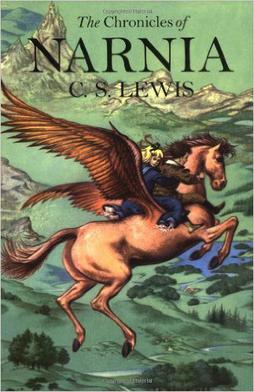
The Chronicles of Narnia is a series of seven portal fantasy novels by British author C. S. Lewis. Illustrated by Pauline Baynes and originally published between 1950 and 1956, The Chronicles of Narnia has been adapted for radio, television, the stage, film, and video games. The series is set in the fictional realm of Narnia, a fantasy world of magic, mythical beasts and talking animals. It narrates the adventures of various children who play central roles in the unfolding history of the Narnian world. Except in The Horse and His Boy, the protagonists are all children from the real world who are magically transported to Narnia, where they are sometimes called upon by the lion Aslan to protect Narnia from evil. The books span the entire history of Narnia, from its creation in The Magician's Nephew to its eventual destruction in The Last Battle.
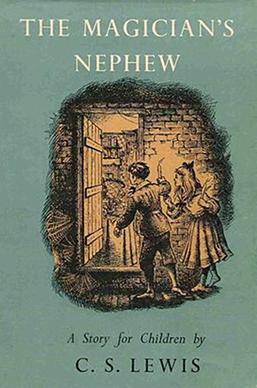
The Magician's Nephew is a portal fantasy children's novel by C. S. Lewis, published in 1955 by The Bodley Head. It is the sixth published of seven novels in The Chronicles of Narnia (1950–1956). In recent editions, which sequence the books according to Narnia history, it is volume one of the series. Like the others, it was illustrated by Pauline Baynes whose work has been retained in many later editions. The Bodley Head was a new publisher for The Chronicles, a change from Geoffrey Bles who had published the previous five novels.
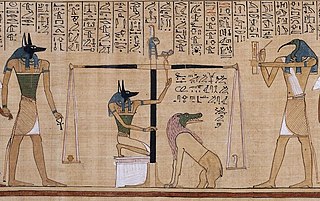
The Book of the Dead is an ancient Egyptian funerary text generally written on papyrus and used from the beginning of the New Kingdom to around 50 BC. The original Egyptian name for the text, transliterated r(ꜣ)w n(y)w prt m hrw(w), is translated as Book of Coming Forth by Day or Book of Emerging Forth into the Light. "Book" is the closest term to describe the loose collection of texts consisting of a number of magic spells intended to assist a dead person's journey through the Duat, or underworld, and into the afterlife and written by many priests over a period of about 1,000 years. In 1842, the Egyptologist Karl Richard Lepsius introduced for these texts the German name Todtenbuch, translated to English as 'Book of the Dead'.

Edith Nesbit was an English writer and poet, who published her books for children as E. Nesbit. She wrote or collaborated on more than 60 such books. She was also a political activist and co-founder of the Fabian Society, a socialist organisation later affiliated to the Labour Party.

Ninurta (Sumerian: 𒀭𒊩𒌆𒅁: DNIN.URTA, possible meaning "Lord [of] Barley"), also known as Ninĝirsu (Sumerian: 𒀭𒎏𒄈𒋢: DNIN.ĜIR2.SU, meaning "Lord [of] Girsu"), is an ancient Mesopotamian god associated with farming, healing, hunting, law, scribes, and war who was first worshipped in early Sumer. In the earliest records, he is a god of agriculture and healing, who cures humans of sicknesses and releases them from the power of demons. In later times, as Mesopotamia grew more militarized, he became a warrior deity, though he retained many of his earlier agricultural attributes. He was regarded as the son of the chief god Enlil and his main cult center in Sumer was the Eshumesha temple in Nippur. Ninĝirsu was honored by King Gudea of Lagash (ruled 2144–2124 BC), who rebuilt Ninĝirsu's temple in Lagash. Later, Ninurta became beloved by the Assyrians as a formidable warrior. The Assyrian king Ashurnasirpal II (ruled 883–859 BC) built a massive temple for him at Kalhu, which became his most important cult center from then on.

The Horse and His Boy is a fantasy novel for children by C. S. Lewis, published by Geoffrey Bles in 1954. Of the seven novels that comprise The Chronicles of Narnia (1950–1956), The Horse and His Boy was the fifth to be published. The novel is set in the period covered by the last chapter of The Lion, the Witch, and the Wardrobe during the reign of the four Pevensie children as Kings and Queens of Narnia. Though three of the Pevensies appear as minor characters in The Horse and His Boy, the main characters are two children and two talking horses who escape from Calormen and travel north into Narnia. On their journey, they learn of the Prince of Calormen's plan to attack Archenland, and warn the King of Archenland of the impending strike.

Five Children and It is a children's novel by English author E. Nesbit. It was originally published in 1902 in the Strand Magazine under the general title The Psammead, or the Gifts, with a segment appearing each month from April to December. The stories were then expanded into a novel which was published the same year. It is the first volume of a trilogy that includes The Phoenix and the Carpet (1904) and The Story of the Amulet (1906). The book has never been out of print since its initial publication.
Nisroch was, according to the Hebrew Bible, a god of Assyria in whose temple King Sennacherib was worshiping when he was assassinated by his sons Adrammelech and Sharezer.
In C. S. Lewis's Chronicles of Narnia series of novels, Calormen is a large country to the southeast of Narnia. Lewis probably derived its name from the Latin calor, meaning "heat". When using the name as an adjective or an ethnonym, Lewis spelled the name with an 'e' at the end: a Calormene soldier; "The Calormenes have dark faces and long beards."

The Phoenix and the Carpet is a fantasy novel for children, written by E. Nesbit and first published in 1904. It is the second in a trilogy of novels that begins with Five Children and It (1902), and follows the adventures of the same five children: Cyril, Anthea, Robert, Jane and the Lamb. Their mother buys the children a new carpet to replace one from the nursery that they have destroyed in an accidental fire. The children find an egg in the carpet, which hatches into a talking Phoenix. The Phoenix explains that the carpet is a magic one that will grant them three wishes a day. The five children go on many adventures, which eventually wear out their magic carpet. The adventures are continued and concluded in the third book of the trilogy, The Story of the Amulet (1906).
Aravis is a fictional character in the 1954 novel The Horse and His Boy by C. S. Lewis.
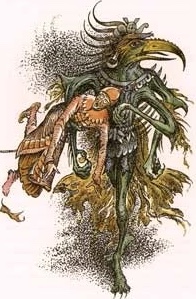
Tash is a fictional deity and demonic god, found in C. S. Lewis's Chronicles of Narnia series. He is an antagonist in the novels The Horse and His Boy and The Last Battle.
Naacal is the name of an ancient people and civilization first claimed to have existed by British-American archaeologist Augustus Le Plongeon and subsequently by British occult writer James Churchward.
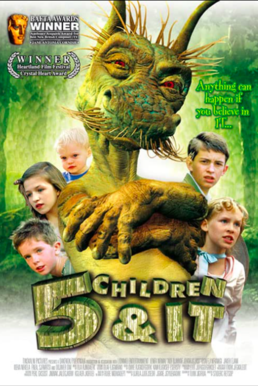
Five Children and It is a 2004 family fantasy-comedy-drama adventure film adaptation of the 1902 novel Five Children and It, which features live action and computer animation. It was directed by John Stephenson, produced by Nick Hirschkorn, Lisa Henson and Samuel Hadida, written by E. Nesbit and David Solomons with music by Jane Antonia Cornish and starring Tara FitzGerald, Freddie Highmore, Alex Jennings, Jonathan Bailey, Jessica Claridge, Poppy Rogers, Alec Muggleton, Zak Muggleton, Zoë Wanamaker, Kenneth Branagh, Alexander Pownall, Robert Tygner, Eddie Izzard as the voice of It-Psammead, Georgio Serafini, John Sessions, Kim Fenton, Norman Wisdom and Duncan Preston and Zak.

An amulet, also known as a good luck charm or phylactery, is an object believed to confer protection upon its possessor. The word "amulet" comes from the Latin word amuletum, which Pliny's Natural History describes as "an object that protects a person from trouble". Anything can function as an amulet; items commonly so used include statues, coins, drawings, plant parts, animal parts, and written words.

Scarabs are beetle-shaped amulets and impression seals which were widely popular throughout ancient Egypt. They still survive in large numbers today, and are popular among collectors of ancient artifacts. Through their inscriptions and typology, they prove to be an important source of information for archaeologists and historians of the ancient world, and represent a significant body of ancient Egyptian art.
Anthea, "blossom" in Greek, was an epithet of the Classical Greek goddess Hera, and is used as a female given name in English.
The following outline is provided as an overview of and topical guide to Narnia:

The Phoenix and the Carpet is a BBC Television adaption of the 1904 book of the same name by E. Nesbit about four children in Edwardian England who acquire a phoenix and the adventures they have as a result.














